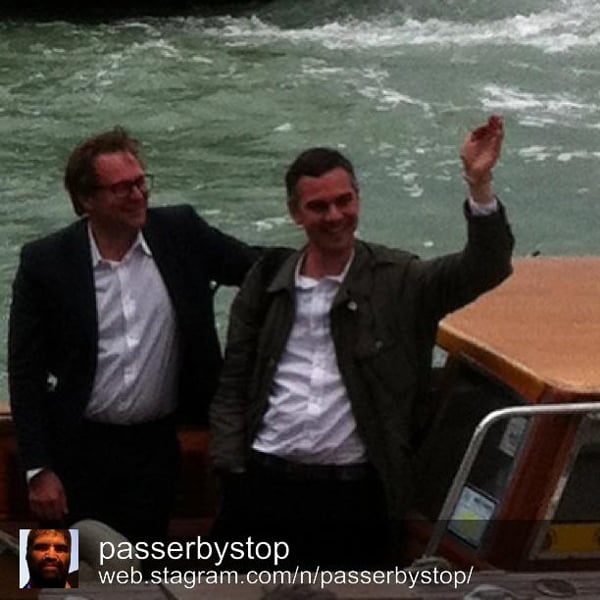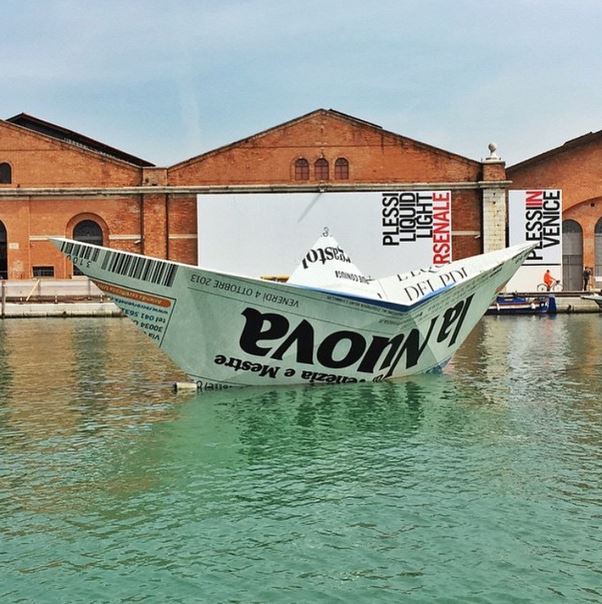As the world’s oldest biennial opens for its fifty-sixth edition, the thing now called “the global art world” descends on Venice for a non-stop week of openings, press breakfasts, VIP brunches, and after-parties. The point of all the partying is to celebrate the artistic efforts of the artists representing the 89 national pavilions and the 44 collateral events, and those in biennale director Okwui Enwezor’s own huge curated exhibition, titled “All the World’s Futures.”
“All the World’s Futures” is a massive, rambling essay supposed to be all about the political state of the world today, a world wracked, Enwezor contends, by “violent turmoil, panicked by specters of economic crisis and viral pandemonium, secessionist politics and a humanitarian catastrophe on the high seas, deserts, and borderlands, as immigrants, refugees, and desperate peoples seek refuge in seemingly calmer and prosperous lands. Everywhere one turns new crisis, uncertainty, and deepening insecurity across all regions of the world seem to leap into view.”
Cheery stuff to party to, right? Especially when, while the thousands of jet-set global artworlders were busy trying not to get their Louboutins wet hopping from the vaporetto to the quayside at one end of the Mediterranean, at the other, thousands of desperate Libyan migrants were busy trying not to drown to death in the locked holds of gangster-run hulks, as they attempted desperately to get to the “seemingly calmer and more prosperous,” yet immigrant-phobic land of the EU.
Desperate outsiders trying to get into the land of plenty: if the humanitarian catastrophe unfolding in the southern Mediterranean wasn’t so horrific, we might be tempted to use it as a metaphor for the Biennale itself. After all, in the age of globalization, ever increasing numbers of countries want “in” on the Biennale: in 1999 there were 61 countries participating; this time round there are 89, along with 44 “collateral events” of non-national organizations. In the pluralist, utopian rhetoric of the Biennale, of course, this can only be a positive thing–a greater inclusivity, a greater diversity of nations and cultures, more international contact, exchange, and understanding, a great united nations of art, and so on. Who could be against that?
Being part of a system that is the problem, not the solution
But in the midst of the globalization hype-speak, it’s worth wondering what the more international, less Eurocentric Venice Biennale actually represents. For all the attention to the chaotic scenery of contemporary global existence “out there” that Enwezor’s exhibition proposes, for all the diverse issues of national identity, history, and politics that preoccupy the pavilions and collateral events, for all the non-stop reading of Karl Marx’s Das Kapital as the “centerpiece” of Enwezor’s exhibition, no one really wants to question why the world’s burgeoning art elites are so keen to gather on this weird, sinking, pretty little island every two years–to ask what function the Biennale serves. Could it be that in the partying and the networking, and all the talk of politics and capitalism, the real point for all these countries and non-countries is to be part of the new machinery of the global economic world order, of which art biennials have become the cultural window-dressing?
It’s ironic that as the cultural system of the international biennial has developed, the thematics that their top-ranking globetrotting curators have gone for have been increasingly about the big, global, political scene–usually with vaguely hysterical, apocalyptic overtones. Massimiliano Gioni’s last Venice Biennale was a case in point, and it’s almost as if Enwezor is trying to one-up Gioni in the planet-scale vision of the world going to hell in a handcart. (All that quoting of Walter Benjamin–enough already!) But underneath all the political posturing, what it really represents is a bad case of disavowal–of not wanting to admit that you’re part of a system that is the problem, not the solution.

Gulf Labour Coalition Who is Building the Guggenheim Abu Dhabi (2015) Installed at Okwui Enwezor’s show at the Arsenale
Photo: via Instagram/#friezevenice
Some might object to this interpretation, pointing to how biennials like Venice allow for the politically voiceless to be heard, and for artists who were once marginal to be welcomed onto the international scene, artists who often have political messages that struggle to be heard in their own countries; that biennials can offer a “critical” take on the world, and that art is uniquely placed to articulate it. Unfortunately, that’s no more than a handy myth, designed to make curators and artists feel better about being part of a rootless diaspora of cultural functionaries whose main aim is to perpetuate itself internationally, while distancing itself as much as possible from its origins. Since whether it does so by making art about politics or not, the underlying system is the same–an increasingly international, mobile, dislocated audience talking mostly to itself, in a system driven haplessly by the dynamics of global capital.
Don’t bring your screwed-up “real” politics into the polished world of the Biennale
In an unguarded moment during the opening press conference on Wednesday, Biennale di Venezia director Paolo Baratta mentioned the three countries that have chosen to withdraw from the Biennale at the eleventh hour (Costa Rica, Kenya and Nigeria), expressing his relief that those countries had not brought their fractious “polemics” to the heart of the biennale. In Costa Rica’s case, the show was pulled when it transpired that the curator was charging artists for their participation, most of which were Italian, not Costa Rican. In Kenya’s case, it turned out that the same (Italian) curators who had presented the Kenya Pavilion in 2013–including a majority of Chinese artists–had pulled the same trick this year (see Venice Loses Two National Pavilions, as Kenya and Costa Rica Pull Out).
Asked by one journalist why, if the biennial was so keen on “polemics,” Baratta should not welcome the troubled “polemics” of these countries, the Biennale’s boss hastily backtracked, explaining that he meant by “polemics” was the internal administrative controversies that led to those cancellations. Now, the Kenyan case might be just another case of low-level dodgy dealing between opportunistic artists and clueless government ministers in countries which haven’t really figured out what the Biennale is about, but the bizarre inclusion of Chinese artists stands out because of what it reveals about the real working of the new global economic order–China is trading heavily with Kenya for its commodities and exploring for oil there. So what Baratta was really saying is that he didn’t want anyone bringing their screwed-up, badly organized, “real” politics into the smoothly professional, polished world of the Biennale.
After declaring that there would be new regulations for how national governments would appoint curators, Baratta then went off on a rambling explanation about how the biennale was not interested in the market–”the work of art in its beginning, not where it ends up”–while musing cryptically about how the biennale was investigating “the mystery of creation.” Let’s keep politics (of the market, of culture) out of this, shall we?

Daniel Birnbaum and Massimiliano Gioni captured by art dealer Gavin Brown
Photo: via Instagram/@passerbystop
Fodder for the new global class of cultural entrepreneurs
What the Biennale doesn’t want to investigate is the mystery of its own creation. Why should it? Who really needs this vast moot for an increasingly homogenous and international style of slightly-political, issues-based art? Not the visiting public, for sure–we’ll look at anything, but we’re not the ones making it happen. No, who really needs it is the new global class of cultural entrepreneurs for which art has become a truly international opportunity, as the emerging economic regions seek to assert themselves on the world stage through the vehicle of the new global art culture. But however political these curators and artists think themselves, the art itself changes absolutely nothing. The Chinese still need oil, the European Union still shuts the door on immigrants, Libyans still drown in ships sinking in sight of the coast of Italy–little more than subject matter for yet more self-regarding political art.








